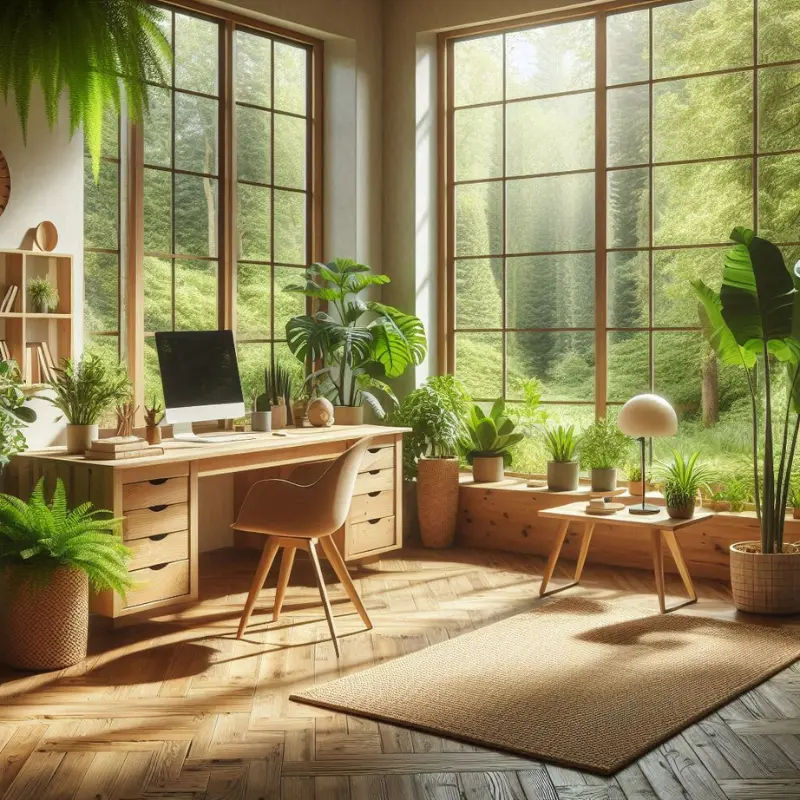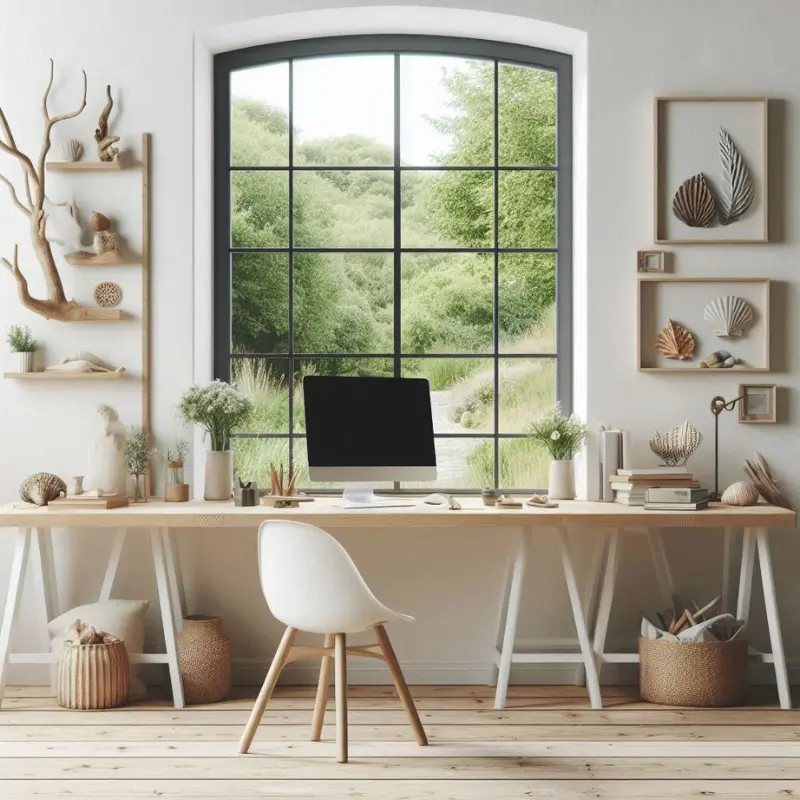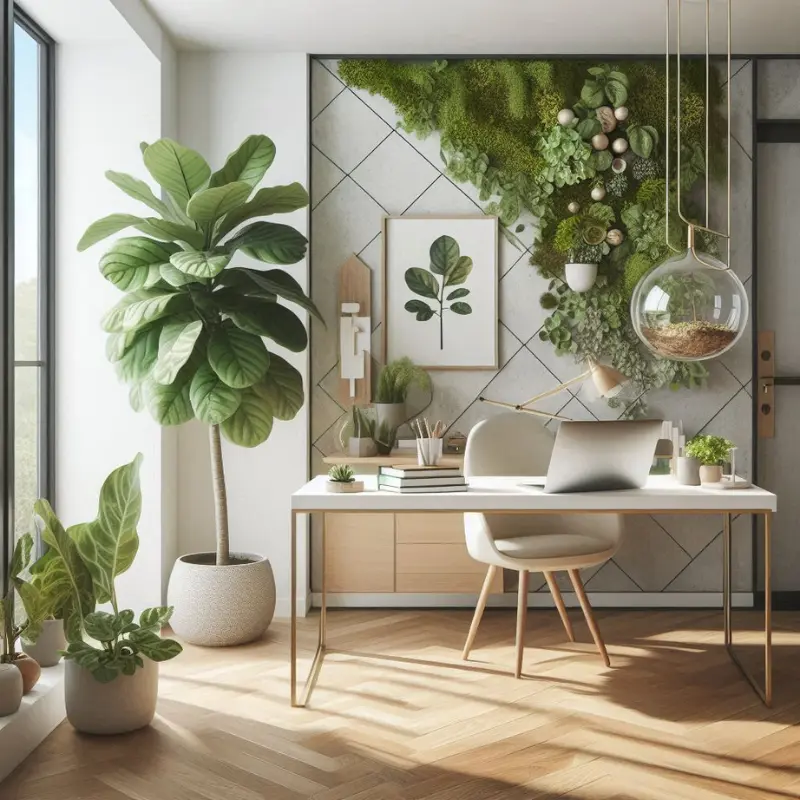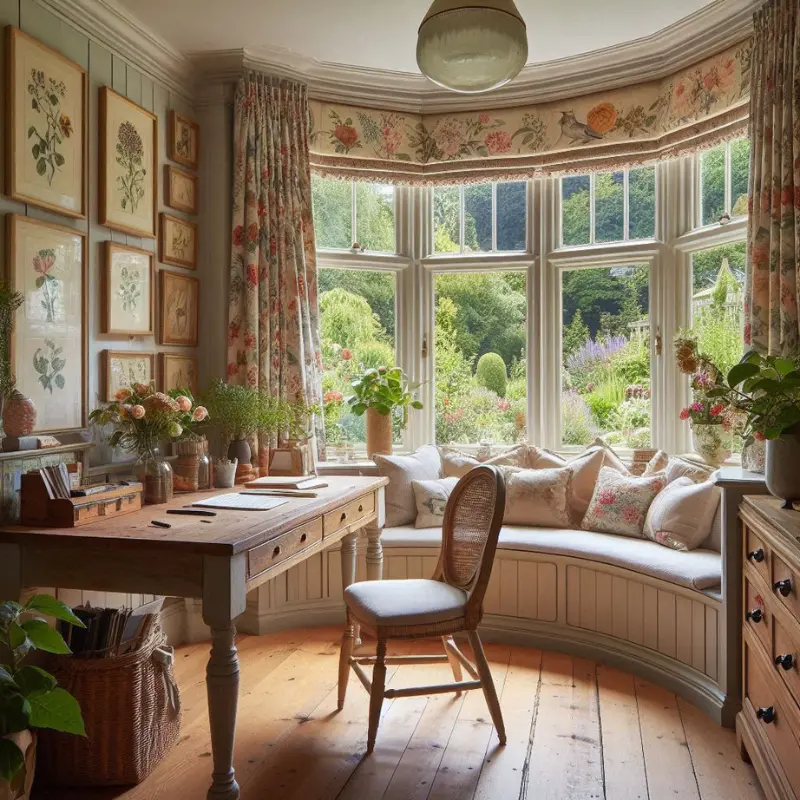Let’s face it, home offices can easily morph into chaotic battlegrounds. Stacks of paperwork become mini-Everests, that to-do list seems to multiply like rabbits, and before you know it, stress levels are through the roof. But what if there was a way to transform your home office into a sanctuary of calm, a space that fosters focus and boosts productivity – all by harnessing the power of nature? Enter the world of biophilic design elements for a calming home office environment.
Biophilic design is all about incorporating elements of nature into the built environment. It’s about acknowledging our innate human connection with the natural world and leveraging that connection to create spaces that promote well-being. Imagine a home office bathed in soft, natural light, with a trickling tabletop fountain providing a soothing backdrop. Or picture yourself working amidst a mini urban jungle of air-purifying plants. These are just a few examples of how biophilic office ideas can transform your workspace.
But biophilia goes way beyond just houseplants (although those are fantastic too!). Today, we’ll delve into a diverse range of biophilic design elements that can create a calming and nature-inspired home office environment, no matter your budget or space constraints.

Exploring Diverse Biophilic Design Elements
A Symphony of Nature’s Materials
Imagine working at a desk crafted from warm, earthy wood, its natural grain a constant reminder of living trees. Or picture yourself surrounded by woven textures and calming stone accents. Biophilic design encourages the use of natural materials like wood, stone, bamboo, cork, and even wool. These materials not only bring a touch of the outdoors in, but they also tend to be more durable and aesthetically pleasing than synthetic alternatives.
Think about incorporating a beautiful live-edge wood desk, a woven jute rug beneath your chair, or perhaps a sleek marble lamp to add a touch of sophistication. The textures and variations found in natural materials create a sense of visual interest and connection to the natural world.
Nature’s Patterns: A Feast for the Eyes
Our brains are wired to find comfort in patterns. Look closely at a seashell, a spiderweb, or even the arrangement of leaves on a tree – nature is full of mesmerizing patterns. Biophilic design utilizes these natural patterns to create calming and visually stimulating environments.
Consider incorporating wallpaper with a nature-inspired motif, like a subtle leaf print or a calming wave pattern. You could also opt for textiles with geometric patterns reminiscent of honeycomb structures or flowing rivers. Even a strategically placed bowl of smooth pebbles on your desk can introduce a delightful, organic pattern.
Harnessing the Power of Natural Light
Natural light is a game-changer when it comes to biophilic office design. Studies have shown that exposure to natural light can significantly reduce stress, improve mood, and even boost cognitive function. So, ditch the harsh overhead fluorescents and maximize the use of natural light instead.
Open your curtains and blinds as much as possible, and consider rearranging your furniture to take advantage of available sunlight. If your workspace lacks ample natural light, try installing skylights or strategically placed task lamps with warm white bulbs that mimic natural daylight.
Biomorphic Forms: Nature’s Soft Touches
Biomorphic forms are shapes inspired by natural elements like leaves, flowers, or even animal forms. These organic shapes have a calming effect on our brains and can introduce a sense of whimsy and playfulness into your home office.
Think about incorporating a chair with a curved back reminiscent of a flower petal or a lamp with a base shaped like a smooth riverstone. You could even choose artwork featuring organic forms like swirling clouds or cascading waterfalls.
The Benefits of Biophilic Design Elements in Your Home Office
A nature-inspired home office doesn’t just look beautiful; it can significantly improve your well-being. Studies have shown that incorporating biophilic design elements into our surroundings can have a profound impact on our health and well-being. Here are just a few of the benefits:
- Reduced Stress and Improved Focus: Numerous studies have shown that exposure to natural elements can lower stress levels, improve cognitive performance, and enhance concentration. By surrounding yourself with biophilic design elements, you create an environment that promotes relaxation and focus, enabling you to tackle even the most demanding tasks with ease.
- Boosted Creativity and Inspiration: Nature’s beauty and diversity are boundless sources of inspiration. By incorporating biophilic design elements into your home office, you expose yourself to ever-changing patterns, textures, and forms that can spark new ideas and creative solutions.
- Improved Air Quality and Well-being: Natural materials and plants can act as natural air purifiers, filtering out harmful pollutants and replenishing the air with oxygen. This improved air quality not only contributes to better respiratory health but also elevates your overall sense of well-being, allowing you to work with vitality and clarity.

The Green That Saves Green: Cost Benefits of Biophilic Design
While biophilic design might seem like an aesthetic choice, the benefits extend far beyond healthy well-being and visual appeal. Studies have shown that incorporating these elements into your home office can lead to significant cost savings in several key areas:
- Reduced Sick Leave: A study by the University of Life Sciences, Norway, found that employees with access to views of nature experience a 10% reduction in short-term absenteeism (https://riworkplace.com/workplace-in-focus-benefits-of-biophilic-design/). This translates to direct cost savings for businesses in terms of employee healthcare and replacement labor.
- Enhanced Productivity: Research by Texas A&M University suggests that exposure to nature can improve cognitive function and task performance by up to 15% (https://www.terrapinbrightgreen.com/). In a home office setting, this translates to increased productivity and the ability to accomplish more work in less time.
- Lower Energy Bills: Biophilic design can contribute to energy savings in a couple of ways. Strategically placed plants can help regulate indoor temperature, reducing reliance on heating and air conditioning. Additionally, maximizing natural light through proper window placement can minimize the need for artificial lighting during the day.
Quantifying the Cost Benefits
While it’s difficult to pinpoint an exact figure due to varying factors, some studies offer valuable insights. A report by the International WELL Building Institute found that biophilic design strategies can generate a return on investment (ROI) of 21:1 through increased productivity and reduced absenteeism (https://growingroots.com/indoorplants/wp-content/uploads/2022/07/Economics-of-Biophilic-Design-Complimentary-Edition-050620.pdf). Translating this to a home office setting, even a modest gain in productivity and focus can lead to significant cost savings over time.
Beyond the Numbers
The cost benefits of biophilic design go beyond easily quantifiable metrics. A calmer and more restorative workspace can lead to reduced stress and improved employee morale, fostering a more positive and engaged work environment.
By incorporating biophilic design elements into your home office, you’re not just creating a more aesthetically pleasing space; you’re investing in your well-being, productivity, and ultimately, your bottom line.
Addressing Challenges and Misconceptions about Biophilic Design
Biophilic design is a rapidly growing trend, even influencing the field of biophilic architecture. While there are numerous benefits to consider, there can be some challenges and misconceptions to address, such as limited space or concerns about plant maintenance. However, with a little creativity and these helpful tips, you can overcome these hurdles and design a calming and productive workspace:
- Limited Space: As mentioned earlier, even small spaces can embrace biophilia with creative solutions. If you have a small office, prioritize vertical space. Use hanging plants or wall-mounted shelves to incorporate natural elements without cluttering your desk. Incorporate smaller potted plants, or use nature-inspired patterns and textures to create a sense of natural ambiance.
- Maintenance Concerns: Many may worry that incorporating living plants or natural materials will require excessive maintenance. Not everyone has a green thumb. However, with careful planning and the right choices, biophilic design elements can be low-maintenance and long-lasting. Consider easy-to-care-for plants or preserved botanical elements. Opt for low-maintenance plants like succulents or snake plants, or consider using high-quality artificial plants. Taking care of plants requires some effort. Set a regular watering schedule and research the specific needs of your chosen plants.
- Budget Constraints: Biophilic design doesn’t have to be expensive. Start with budget-friendly options like repurposing natural materials, incorporating thrifted or secondhand decor pieces, or exploring DIY projects that align with your design vision. Simple changes like adding a plant or using natural light can make a big difference without breaking the bank.
- Misconception – “Biophilic Design is Just About Plants”: While plants are a key component, biophilic design encompasses a wide range of elements like natural materials, lighting, and patterns. It’s about creating a holistic connection to nature.
- Misconception – “It’s Only for Large Spaces”: Biophilic design can be adapted to any space, large or small. As mentioned earlier, even a small home office can benefit from the thoughtful integration of natural elements. Vertical gardens, small potted plants, and strategic use of natural light can work wonders in compact spaces.

Integrating Biophilia into Your Home Office
Now that you understand the power of biophilic design, let’s explore how to incorporate these elements into your home office, whether you’re starting from scratch or revamping an existing space. Here are some tips on how to incorporate biophilic design into your workspace, even if you’re tight on space or budget.
Space Constraints? No Problem!
Even the most compact home offices can benefit from biophilic design. Here are some clever solutions for smaller spaces:
- Vertical Gardens: Utilize vertical space with hanging planters or wall-mounted living walls. Air plants are a low-maintenance option for vertical gardens.
- Terrariums: Create a miniature ecosystem with a beautiful terrarium on your desk.
- Nature-Inspired Artwork: A strategically placed photograph of a serene landscape or a calming seascape can bring a touch of nature indoors.
- Window Film: Transform a plain window into a portal to nature with decorative window film featuring nature scenes or calming patterns.
Budget-Friendly Biophilia
Biophilic design doesn’t have to break the bank. Here are some cost-effective ways to bring nature into your home office:
- Foraged Elements: Take a walk in your local park or nature reserve and collect fallen leaves, interesting pebbles, or even small twigs to create a natural centerpiece for your desk.
- DIY Projects: Get creative and craft your own biophilic elements. Build a simple wooden planter box for your favorite plant or use recycled materials to create a unique lamp with a natural theme.
- Thrift Store Finds: Look for nature-inspired artwork, vases, or sculptures at thrift stores or flea markets. You might be surprised by the hidden gems you can uncover!
Personalizing Your Biophilic Oasis
Biophilic design is all about creating a space that reflects your own connection with nature. Here are some ways to personalize your home office:
- Incorporate calming scents: Use essential oil diffusers with natural scents like lavender or chamomile to promote relaxation.
- Bring in the sounds of nature: Play calming nature sounds like babbling brooks or gentle ocean waves to create a peaceful atmosphere.
- Let there be (natural) light!: Invest in dimmable lighting fixtures that allow you to adjust the light based on the time of day and your mood.
Maintenance Tips for Biophilic Design Elements
Your home office makeover is complete, and you’re now surrounded by the calming presence of nature. But remember, a biophilic design thrives with proper care. Here are some tips to ensure your nature-inspired haven flourishes:
Plant Power
- Research Plant Needs: Each plant has unique watering, sunlight, and soil requirements. Do your research to ensure your chosen flora thrives in your home office environment.
- Watering: Develop a consistent watering schedule to avoid underwatering or overwatering your plants. Consider self-watering planters or apps that remind you to water your leafy companions.
- Cleaning: Wipe down leaves regularly to remove dust and promote better light absorption for photosynthesis.
Natural Light Matters
- Embrace the Sunshine: Keep windows clean to maximize natural light penetration. Open blinds and curtains whenever possible to bathe your workspace in sunlight throughout the day.
- Rotate for Balance: If your home office layout doesn’t offer even sunlight distribution, rotate plants periodically to ensure all sides receive adequate light.
A Breath of Fresh Air
- Ventilation is Key: Whenever weather permits, open windows to allow fresh air circulation. This not only benefits your plants but also introduces invigorating natural scents and promotes overall air quality.
- Use Air Purifier: Consider using an air purifier, particularly if your home office has limited ventilation. This can help remove pollutants and allergens, creating a healthier work environment.
Maintaining the Harmony
- Declutter Regularly: Clutter disrupts the calming effect of a biophilic design. Schedule regular decluttering sessions to maintain a clean and organized workspace.
- Refresh and Renew: Switch up your nature-inspired artwork or photographs periodically to keep your space feeling fresh and inspiring.
By following these simple maintenance tips, you can ensure your biophilic design elements continue to thrive and contribute to a calming and productive home office environment for years to come. Remember, a little care goes a long way in keeping your nature-inspired oasis flourishing!

Perspectives from Industry Experts and Professionals
Biophilic designs are gaining traction in the world of home office design, and for good reason. Below, we explore the topic through the lens of three industry experts and professionals:
“Biophilic design elements for a calming home office environment are more than just aesthetics; they’re about creating a space that feels nurturing and restorative. By incorporating natural materials like wood and stone, alongside calming water features and strategically placed plants, we can create a sense of connection to nature, which has been shown to reduce stress and improve focus. In essence, biophilic design allows us to transform home offices into sanctuaries that inspire productivity and well-being.”
– Nadia Sharma, a renowned interior designer specializing in biophilic spaces
“Biophilic design elements shouldn’t be an afterthought in home office design. When incorporated strategically, they can significantly enhance the functionality of the space. For instance, maximizing natural light with large windows not only creates a calming atmosphere but also reduces reliance on artificial lighting, leading to energy savings. Similarly, incorporating natural ventilation promotes air circulation and overall well-being. By prioritizing these biophilic elements, we can create home offices that are not just beautiful but also optimized for peak performance.”
– Darren Fisher, a leading architect known for his integration of biophilic principles
“The concept of biophilic design elements for a calming home office environment resonates deeply with the mind-body connection. Studies have shown that exposure to nature reduces cortisol levels, the stress hormone, while also promoting cognitive function and creativity. In a home office setting, this translates to improved focus, better decision-making, and ultimately, a sense of calm that allows us to approach our work with a renewed sense of purpose. By embracing biophilic design principles, we can create home offices that support not just our productivity but also our overall well-being.”
– Dr. Lisa Wright, a wellness expert specializing in workplace design
Testimonials: Biophilic Design in Action
The power of biophilic design elements isn’t just theoretical. Below, we explore real-life examples of people who have transformed their workspaces and experienced the benefits firsthand:
From Chaotic to Zen – A Biophilic Home Office Makeover
“My home office used to be a cluttered mess, and my stress levels were constantly through the roof. I barely had room to breathe, let alone focus on work. Then, I discovered the concept of biophilic design. I started by incorporating some low-maintenance plants like snake plants and brought in a natural light lamp to brighten up the space. I also decluttered ruthlessly and replaced my old, bulky desk with a sleek wooden one. The difference is incredible! My home office feels so much calmer and more organized now. The plants add a touch of life, and the natural light makes it so much more pleasant to work in. My productivity has definitely improved, and I actually find myself enjoying spending time in my home office!” – Eleanor Moore, Marketing Manager
Boosting Creativity with a Biophilic Workspace
“As a freelance writer, I rely heavily on creativity, but my old home office felt stifling and uninspiring. I decided to implement some biophilic design elements to see if it could make a difference. I installed a skylight to bring in more natural light, hung some nature-inspired artwork, and even added a small tabletop water fountain for a calming backdrop sound. The change has been remarkable! The natural light gives me a much-needed energy boost, and the sounds of the water fountain help me stay focused. The artwork adds a touch of whimsy and inspires new ideas. I never thought a few simple changes could make such a big difference in my creative process!” – Gregory Thorne, Freelance Writer
Biophilic Design on a Budget: A Student’s Success Story
“As a college student, my budget for decorating my home office was tight. However, I was determined to create a calming and focused workspace. I started by visiting my local park and collected some fallen leaves and interesting pebbles. I arranged them in a decorative bowl on my desk, and it surprisingly made a big difference. I also found some beautiful nature photographs online and printed them out to frame and hang on the wall. The natural elements add a touch of serenity to my workspace, and it helps me stay focused on my studies even when things get hectic. Biophilic design doesn’t have to be expensive; a little creativity can go a long way!” – Paige Miller, College Student
My Experience as a Home Office Owner
Like many of you, my home office journey wasn’t exactly a walk in the park (pun intended!). My workspace started as a catch-all for clutter, a chaotic haven for to-do lists and mounting stress. Deadlines loomed large, and my focus felt scattered. But then, I stumbled upon the concept of biophilic design elements for a calming home office environment. Intrigued, I decided to give it a try, and let me tell you, it’s been a game-changer.
My biophilic transformation began with the most obvious element: natural light. I rearranged my furniture to maximize the sunlight streaming through my window, instantly making the space feel more open and inviting. Next came the greenery. I introduced a few low-maintenance plants like a snake plant and a pothos, adding a touch of life and a natural air purifier to boot. The calming effect was immediate – just a glance at their vibrant leaves offered a welcome escape from the digital world.
But it wasn’t just about plants. To further enhance the calming atmosphere, I incorporated a soft, woven rug beneath my chair, introducing a natural texture that felt grounding and serene. On the wall, I replaced a generic motivational poster with a framed photograph of a cascading waterfall – the sound of rushing water, recreated with a nature sounds app, became my go-to stress reliever during intense work sessions.
The transformation of my home office hasn’t just been aesthetic; it’s impacted my well-being in real ways. The biophilic design elements have created a noticeably calmer environment. My stress levels have dipped, and my focus has sharpened. Gone are the days of feeling frazzled in my workspace – now, I find myself entering my home office with a sense of calm determination, ready to tackle any challenge that comes my way.
This experience has solidified my belief in the power of biophilic design. It’s a testament to the fact that even small changes, inspired by nature, can have a profound impact on our productivity and overall well-being. So, if you’re looking to transform your home office into a sanctuary of focus and calm, I urge you to embrace the power of biophilia. You might be surprised at how much a touch of nature can transform your workspace, and ultimately, your work life.

References and Resources
If you’re inspired to incorporate biophilic design elements for a calming home office environment, here are some additional references and resources to help you delve deeper:
Books and Publications
- “Biophilic Design: The Theory, Science, and Practice of Bringing Buildings to Life” by Stephen R. Kellert
– This book is a comprehensive guide to understanding the principles of biophilic design and how to apply them in various built environments. It’s an essential read for anyone serious about integrating nature into their workspace.
- “Nature Inside: A Biophilic Design Guide” by William D. Browning and Catherine O. Ryan
– This guide provides practical tips and stunning visuals to help you understand and implement biophilic design in your home office.
- “The Nature Fix: Why Nature Makes Us Happier, Healthier, and More Creative” by Florence Williams
– While not exclusively about biophilic design, this book explores the profound impact of nature on our well-being and creativity, reinforcing the importance of integrating natural elements into our daily lives.
- “The Healing Nature: Integrating Nature Design Patterns for the Health and Well-being of People” by Roger S. Ulrich
Online Resources and Communities
- The International Living Future Institute: A leading organization promoting biophilic design principles in architecture and construction.
- Terrapin Bright Green: Terrapin Bright Green offers a wealth of research and case studies on biophilic design. Their website is a valuable resource for anyone looking to deepen their understanding of the science behind biophilic design.
- Grinde, Bjørn, and Grete Grindal Patil. “Biophilia: Does Visual Contact with Nature Impact on Health and Well-Being?” 2009.
- Gould, Jamie. 10 Tips For Adding Biophilia Features And Benefits To Your Home. 2020.
- Korpela, Kalevi M., et al. “The Role of Nature in Coping with Psycho-physiological Stress: A Literature Review on Restorativeness.” 2017.
- Lohr, Virginia I., et al. “The Effect of Indoor Foliage Plants on Health and Discomfort Symptoms among Office Workers.” 1996.
- Biophilic Cities: This online community focuses on integrating nature into urban environments. While primarily aimed at city planning, the principles discussed can be applied to home office design.
- Pinterest and Instagram: Social media platforms like Pinterest and Instagram are great for finding visual inspiration and practical ideas for biophilic design. Search for hashtags like #biophilicdesign, #natureinspired, and #homeofficeinspo to find creative examples.
- Houzz: Houzz is a platform that connects homeowners with interior design professionals. It features a vast array of photos, articles, and product recommendations that can help you find the perfect biophilic elements for your home office.
Final Thoughts
Biophilic design isn’t just a trend; it’s a way to reconnect with our inherent love of nature and create spaces that nurture our well-being. By incorporating biophilic elements into your home office, you can cultivate a calmer, more focused, and ultimately, more productive work environment. So, unleash your inner nature enthusiast, embrace the power of biophilia, and watch your home office transform into a space that inspires you to flourish!
Also read – How to Transform Your Studio Apartment into a Home Office
Frequently Asked Questions
Q.1 – What are the cognitive benefits of biophilic design?
One of the foremost benefits of biophilic design is its positive impact on mental health and overall well-being. Exposure to natural elements, such as sunlight, greenery, and water features, has been linked to reduced stress, improved mood, and enhanced cognitive function.
Q.2 – What is biophilia in simple words?
The word biophilia originates from the Greek, “philia” meaning “love of”. It literally means a love of life or living things. Humans have a deeply engrained love of nature which is an intuitive and natural drive imprinted into our DNA.
Q.3 – What are the 5 senses of biophilic design?
The biophilic design comprises the 5 senses: Sight, Smell, Touch, Taste, and Hearing.
Q.4 – How does biophilia help mental health?
It teaches valuable skills such as accepting uncertainty, confronting perfectionism, being present, connecting to the earth, connecting with other people, and adopting healthy eating and exercise habits. Gardening can also curb stress as well as reduce symptoms of anxiety and depression.
Q.5 – What are the disadvantages of biophilic design?
If not properly maintained, natural elements can become unsightly or even hazardous. Allergies: For some employees, exposure to natural elements such as plants or flowers can trigger allergies or other health issues. Space limitations: Biophilic design may not be practical for all workspaces.
Share the Biophilic Love!
We’ve explored the wonders of biophilic design and how it can transform your home office into a haven of productivity and peace. But the benefits don’t stop there! Biophilic principles can be applied to any space, from your living room to your child’s bedroom.
Here are some ways you can share the biophilic love:
- Spread the Word: Talk to your friends and family about the benefits of biophilic design and how they can incorporate it into their own homes.
- Get Social: Share your biophilic home office makeover on social media using the hashtag #biophilichomeoffice and inspire others to embrace nature-inspired design.
- Become a Biophilic Advocate: Research and share articles about biophilic design with your community.
- Support Biophilic Businesses: Look for companies committed to sustainable practices and incorporating biophilic principles into their products and services.
By taking action, you can help create a wave of biophilic design that brings the calming and invigorating power of nature into more homes and workplaces. Let’s create a world where we can all thrive in harmony with the natural world, one biophilic space at a time!
Happy Biophilic Designing!
*Images used in this blog post article are for illustrative purposes only. We do not possess any copyrights to these images unless explicitly mentioned.

Nikhil Shukla
About The Author
Nikhil, with a background in Technology, is deeply passionate about Interior Design and Home Décor. At Cherry Hills Home Living, he channels this passion into creating inviting and stylish living spaces. With a unique blend of analytical thinking and creative flair, Nikhil offers innovative ideas, practical tips, and inspiring guidance to help others transform their homes into cozy retreats.